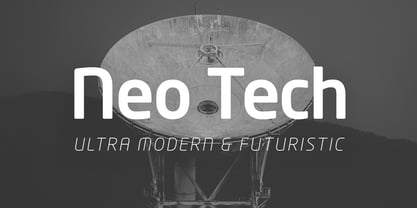Sélectionnez ce type de licence lorsque vous développez une application pour iOS, Android ou Windows Phone et que vous intégrez le fichier de fonte dans le code de votre application mobile.
Neo® Tech
par Monotype
- AaGlyphs
-
Meilleure offreOffres familiales
- Styles individuels
- Spécifications techniques
- Licences
A propos de la famille Neo Tech Police
Neo Sans est né d'une mission intrigante confiée par une agence de stratégie de marque. Le client de l'agence voulait une famille de caractères "ultra moderne" qui soit "futuriste sans être gadget ou éphémère". Lorsqu'une décision bureaucratique a annulé le projet, Sebastian Lester, designer chez Monotype, a décidé de terminer la conception par ses propres moyens. "Je me suis retrouvé avec un carnet de croquis rempli d'idées", a-t-il déclaré, "et j'ai pensé qu'il serait dommage de ne pas voir ce qui en résulterait". Lester a décidé que l'ingrédient principal d'un caractère "ultra moderne" était la simplicité de la structure des caractères : une forme monoline soigneusement dessinée, des formes de lettres ouvertes et des courbes douces et fortes. En amplifiant encore ces qualités, il a franchi la ligne qui sépare le moderne du futuriste. Deux caractères très fonctionnels et polyvalents ont ainsi vu le jour. Il s'agit du Neo Sans et du Neo Tech, que Lester décrit comme "lisibles sans être neutres, nuancés sans être compliqués, et expressifs sans être distrayants". Les familles Neo Sans et Neo Tech, plus minimalistes, sont toutes deux disponibles en six graisses, allant de Light à Ultra, et sont accompagnées d'italiques. Neo Tech offre une série de caractères alternatifs.
Concepteurs : Sebastian Lester
Éditeur : Monotype
Fonderie : Monotype
Maître d'ouvrage : Monotype
MyFonts débout : 13 octobre 2005

À propos Monotype
La bibliothèque de Monotype est l'une des collections de caractères les plus vastes et les plus complètes au monde. Elle comprend des dessins originaux d'importance historique et une nouvelle gamme de caractères contemporains et à la mode : polices. La bibliothèque de Monotype comprend des milliers de classiques intemporels, des reprises artisanales et des dessins originaux provenant des créateurs de caractères et des fonderies les plus innovants de l'histoire. Cette bibliothèque distinctive et primée de polices offre aux marques et aux concepteurs une sélection large et fiable de caractères pour une typographie expressive à l'impression et à l'écran. La page Premium Foundry peut être consultée ici.
En savoir plus
Lire moins